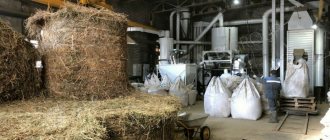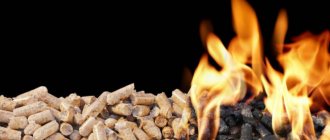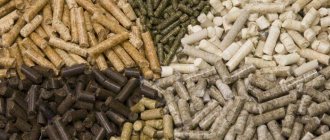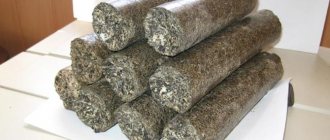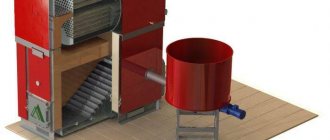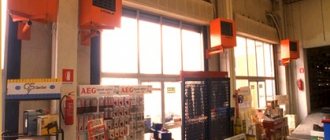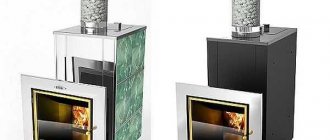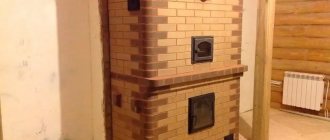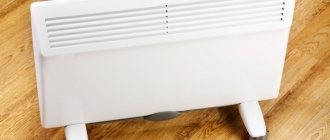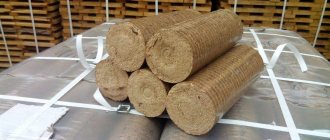Pellets - general information
Pellets are a type of fuel based on a solid composition and are manufactured in the form of cylindrical granules. Production is carried out from compressed industrial waste from the woodworking or agricultural industries. Fuel pellets are primarily made from the following materials:
- From various types of wood (i.e. bark, sawdust and chips of coniferous and deciduous trees);
- From peat;
- From charcoal;
- From the husks of grain crops (cake, sunflower, rapeseed, corn, etc.);
- From combustible household non-toxic waste.
At the same time, a substance of plant origin is used as the main binding substance - lignin (a natural polymer that is found in almost any plant crop). It is capable of plasticization during the granulation process when exposed to elevated production temperatures.
Differences between pellets and other types of fuel
Differences can be found in many parameters, but below it is worth considering only the most basic:
- They can be produced automatically, which will require slightly less industrial resources;
- They have a high calorific value, which qualitatively distinguishes pellets from lump wood (firewood) or tree bark;
- During combustion, they leave virtually no ash behind that could clog the air duct or boiler burner (which cannot be said about coal or wood);
- They have an increased filling capacity, which is convenient for their packaging and subsequent transportation in almost any container;
- Unlike firewood, they occupy less space during storage;
- They are not highly explosive and cannot ignite if handled carelessly, which distinguishes them from any type of liquid fuel or fuel oil.
If we consider the economic side of the issue, we can highlight the following differences:
- Prices for pellets are stable and little dependent on fluctuations in world currencies;
- Due to their properties, they cannot damage the equipment that is used to burn them (for example, clog the boiler air duct), which means a reduction in costs not only for repairs, but also for preventive cleaning of such equipment.
- Speaking about the environmental component of the issue, the following differences can be noted:
- Pellet fuel can be stored in close proximity to residential buildings, because it does not emit harmful emissions and cannot harm human health;
- The granules of this fuel contain only a natural product and are not capable of causing allergic reactions;
- Pellets are completely safe for the environment.
The technical differences can be expressed using the following example, considering how many tons of granular material are required to release 5000 kW of energy:
- For diesel fuel – 500 liters;
- For wood (firewood) – 1600 kilograms;
- For fuel oil – 685 liters;
- For gas – 475 cubic meters.
Production technology
The production process for pellets is based on the pressing of waste from various industries, prepared in advance and dried to a certain moisture level, and then successively crushed to the required fraction, under a pressure of about 300 atmospheres. At the same time, the use of glue and other synthetic additives is prohibited (although some manufacturers, in order to speed up the production process and increase the mass of the granular substance, may add some substances, for example, sand and other low-flammable impurities, and to increase adhesive properties - synthetic-based polymers) .
Basic production steps:
- Grinding - the raw material is fed into a special crusher, where it is crushed to the required level.
- Drying – the resulting raw materials are dried to the humidity percentage established by the technology, which ranges from 8 to 10%.
- Pressing - after drying, the raw material is fed into a pressing granulator, where the substance is pressed in the form of granules to a given length and diameter. During the production of compression, adiabatic processing, friction, the temperature can rise to 100 degrees Celsius, which causes the formation of thermal energy that softens the lignin, and the fractions stick together into a granular form. This process is called pelletization.
- Cooling - at this stage, the strength of the granular substance is ensured and after acquiring its shape it must be cooled.
- Packaging is the final stage of production technology.
In some cases, before the start of crimping, water treatment and a regrinding stage may be carried out, which is necessary when using certain types of raw materials and their quality properties. Crimping is carried out in special molds, ring-type dies using rotary rollers (rollers), which compress the substance into cone-shaped fillers installed on the matrix. On the reverse side, the released granules are trimmed with special knives. Upon completion of the cooling stage, the resulting pellets are sieved and too small fragments are recycled. This technology is, in principle, waste-free, since only low-flammable impurities are removed. Thus, to produce a ton of substance, from three to five cubic meters of wood waste will be required, because compaction occurs approximately three times. Energy consumption for the above process can range from 30 to 50 kW per hour.
Modern types of granules
For boiler equipment burning pellets, the following types of granules are used:
- White (wood) granules are the highest quality and highly effective option, made from sawdust of coniferous trees. They can be easily distinguished by their uniform and light shade, devoid of dark inclusions. Accordingly, the cost of this substance is usually higher than average and ranges from 7 to 8 thousand rubles.
- Modifications with the addition of tree bark are a fairly economical option, in which, in addition to the wood itself, bark is also added. In principle, it is not much inferior to what was described above, but there is a certain condition - only purified bark should be used in the production technology. In most cases, there is some sand on the bark, so the quality of the fuel may be noticeably lower. Colors range from dark gray to brown.
- Sunflower husk granulate is the most inexpensive modification, which is produced in areas where there is a production network involved in the processing of sunflower seeds. In its effectiveness, such granules are inferior to wood-based analogues, and during its combustion, slightly more ash is created.
- The peat option has good heat transfer properties and is produced where there are large peat deposits. The main disadvantage is the increased ash content, however, this circumstance is more than compensated for by the low price - from 5,000 rubles. The color of the substance is black.
- Straw pellets are a rather unusual solution, most often used in areas with small wood reserves. In terms of its effectiveness, it is very much inferior to all the above options.
Which is better - pellets or firewood?
Photo: 66.RU from partners
Pellet fuel has higher heat transfer and calorie content. Granules and briquettes burn better, which is due to various factors, including the high humidity of wood (when heating with wood, a significant part of the energy is spent on evaporating excess moisture, only after which combustion begins).
When you recalculate the cost of biofuel to the volume of thermal energy released, you get not only one of the most efficient, but also affordable types of fuel for boilers. In addition, pellets are much more convenient to store. But the key advantage is the ability to automatically supply fuel.
Difficulties in choosing quality granules
In principle, to choose the most suitable option, you should focus on the following points:
- Length and diameter of granules - the most common diameter is from 2 to 8 millimeters, and, as practice shows, smaller diameters are more often a foreign product. Larger variations are produced by a domestic manufacturer (they usually use equipment that was previously used for the production of granulated feed). However, the dimensions of the granules used should not differ too much from each other, so the simultaneous use of different types of fuel is undesirable.
- Surface – the quality of a substance can be determined by its appearance. If the surface is smooth and shiny, then this means that the production process took place at the proper temperature in compliance with all the rules. If there are a large number of cracks on the granules, then their heat transfer may be in question.
- Hardness – the harder it is to break an individual granule, the better. This also speaks to fuel efficiency and helps eliminate risks during storage and transportation. Situations often arise when, during the movement, most of the substance crumbles into dust, which qualitatively reduces the positive heat transfer during combustion, and, accordingly, a large mass of the substance is spent on heating.
- Color - it will depend on the production raw materials used. If there are too many dark inclusions on the wood granulate, this indicates a fairly high presence of sand in the composition, which will impair heat transfer.
- Liquid Solubility – An excellent way to check quality is to test water solubility. A small handful of pellets is dropped into a container with liquid, where it remains for several hours. The water should completely dissolve them, turning them into a dark, damp mass. When this does not happen, this indicates that polymer substances were used for gluing, which is extremely undesirable. To determine the amount of sand in the composition, you need to shake the container and the sand will sink to the bottom of the container.
IMPORTANT! It is preferable to purchase pellet products in bags, but not in bulk. Such a loose version is more easily damaged and is not able to retain its beneficial properties for a long time, while a plastic bag can protect against the negative effects of moisture and other negative environmental phenomena.
Pros and cons of granulate
The main positive qualities of this type of fuel include:
- Environmental cleanliness - when burning such a substance, the volume of carbon dioxide released is equivalent to the volume that is formed during the natural decomposition of various wood wastes;
- Low fire hazard - pellets are almost not subject to spontaneous combustion, which distinguishes them favorably from other fuel substances;
- Proper humidity - it ranges from 8 to 10% versus 30-50% for ordinary firewood, which makes their storage more reliable;
- Excellent heat transfer - with one ton you can guarantee 3500 kW of energy (which will depend on the type of granules);
- Permanent and high density - this quality has a positive effect on logistics, loading and transportation of pellets;
- Uniformity – the same structure of sizes and shapes makes it easy to automate loading/unloading and combustion procedures.
Significant disadvantages include:
- Inflated cost of fuel in modern conditions;
- To burn pellets, you will need to purchase a special boiler, which is equipped with automation and is quite expensive;
- The small volume of offers available on the market - there is hope that this situation will soon be corrected, but most potential consumers have to make purchases in reserve, which entails the need to look for storage facilities in conditions without excessive humidity.
Advantages of fuel pellets and comparison with firewood
The main advantage of pellet fuel is the possibility of its use in automated systems - solid fuel boilers with a bunker. Fuel supply in such installations occurs automatically, reducing human intervention and ensuring long-term operation of the boiler.
Other benefits
- energy efficiency - granules have a high specific energy intensity;
- acceptable price;
- low ash content - there is no need to constantly clean the boiler, as is the case with firewood;
- high density - emit more heat during combustion;
- environmental friendliness;
- Convenient storage and quick ignition.
These and other advantages make pellets one of the most popular types of dry fuel.
Standardization of granular pellets
At the legislative level in the Russian Federation there is no standardization of them. As a rule, manufacturers independently establish the features of production technology in relation to both the quality of the raw materials used and the quality of the final product. But the main reference point for them is the foreign technologies of those countries where the pellet market has been formed for a long time and where this fuel is very popular.
There is also a similar trend in the pellet combustion boiler market. Each manufacturer, in its instructions, independently dictates the requirements for the fuel used. Warranty obligations are directly dependent on the fulfillment of these technical conditions, which forces direct producers of granulate to focus on them. At the same time, processes must be strictly followed so that the products are in demand among potential buyers.
This shows that the Russian market in this area has not yet been fully formed, and many product indicators have not become common to everyone.
Packaging and packing of pellet granules
There are many ways to package and package the type of fuel in question. This circumstance significantly contributes to the satisfaction of most customer requests. The substance can be sold in bulk, completely free, or in standard bags (“big bags” - from English “big bag”), which can hold from 500 to 1200 kilograms.
As a rule, fuel elements are shipped in bulk and sent to large thermal power plants. However, bulk shipment is also possible for pellets of higher quality. They are purchased by enterprises that carry out further retail sales to private consumers or small stations, while packaging the material in bags of smaller volumes. A regular bag is a soft container made of synthetic polymers, and it is equipped with special reinforced slings to automate loading/unloading work. Materials transported in synthetic bags completely retain their flowability and maintain the proper level of humidity. It is worth noting that the bulk purchase method is much cheaper for the end consumer than the packaged version.
Transportation of packaged goods into “big bags” is carried out by special vehicles on platforms loaded by forklifts. But packaging in bags from 10 to 20 kilograms can be loaded and transported using manual force and small trucks. This is due to the fact that private buyers do not always have a need for large volumes due to problems finding storage space. Also, higher quality pellets are supplied in small quantities.
Types of pellet fuel
Photo: 66.RU from partners
A large selection of biofuel with different characteristics is available for sale:
- white, premium class for heating country houses;
- standard quality;
- fuel used in industry.
The main market share is occupied by white pellets, which are characterized by their high calorific value and versatility - suitable for most automated heating systems.
Briquettes RUF and PINI&KAY
Photo: 66.RU from partners
RUF fuel is an innovative solution for boilers. Briquettes are made in the form of small bricks. The raw material for production is birch dust, subjected to pressing.
To heat your home, you can buy PINI&KAY pellets - biofuel in the form of a hexagonal log. The unique shape and special composition (birch chips and sawdust) provide a high combustion temperature.
Instead of an epilogue
An analysis of the Russian market for the goods in question has established that the middle and budget segments are completely occupied by domestic producers. However, such a product has a single and direct purpose - heating only. At the same time, reasonable prices and variability of supply indicate sufficient quality of products. The premium segment, as a rule, is entirely represented by foreign (primarily European and transatlantic manufacturers), is characterized by a high level of environmental friendliness and can be used in various fields. It is worth mentioning that the price of such quality and multitasking is very high, so the Russian consumer is unlikely to purchase premium samples for heating. They are ideal for grilling and other outdoor cooking tasks. In addition, it should be noted that the market for the goods in question in Russia is just beginning to develop and there is hope that domestic companies will soon begin producing multi-tasking granulates, and the prices for them will not be greatly inflated.
